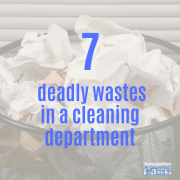7 Deadly “Muda” or Wastes in a Cleaning Department
Toyota is often looked to set a standard in manufacturing, as it has long embraced lean management principles to develop automobiles across the globe. A large part of its success is due to its innovative approach to production, which can be attributed to Taiichi Ohno, father of the Toyota Production System. While lean management originally started with Henry Ford’s assembly line, Ohno further integrated these principles into the Toyota Production System, which formed the basis for lean manufacturing as we know it today.
A central tenant of the Toyota Production System and lean manufacturing is minimizing “muda” —or waste—without sacrificing productivity. From uneven workloads to consumption of materials, limiting waste within an operation is one of the best ways to improve its profitability.
In their paper, “Cleaning as an Engineered Process: Lean Principles for a Neglected Industry,” authors Dr. Jeffrey Campbell and Kathleen Campbell look specifically at how Lean Management Principles can be used within a cleaning department to improve efficiency.
“Lean is implemented by first understanding the activities and practices that are considered wasteful and do not add value to the process. It then looks at the process and identifies what creates value in the process stream and what is wasteful. A culture of continual improvement must be set up so that those who are in the day-to-day work-flow are comfortable with approaching management with new ideas on how to improve processes. Each area also needs to be cleaned and organized so that everything is in its place. With the preceding steps in place, waste can be eliminated or mitigated, and the process can become more Lean.’ The process should be re-evaluated often as new ideas or improvement emerge.”
The “Seven Wastes” model is commonly used in lean and quality management systems such as ISO 9000 and Six Sigma. The wastes Ohno identified include:
- Transportation: The movement of resources or materials without adding value to your product.
- Inventory: Maintaining more product than you need for a given period.
- Motion: Unnecessary movement of employees which may cause injury or are unnecessary.
- Waiting: The absence of movement for goods or tasks (e.g. waiting for items to be fixed, delivered).
- Overproduction: Producing more than you need to meet the customer’s demand or expectation.
- Over-processing: Performing work that doesn’t bring value to the organization or customer.
- Defects: Production of a faulty or defective product.
While a custodial department doesn’t necessarily manufacture a product, they do provide a service and one can easily draw parallels between Ohno’s seven wastes and potential sources of waste in a custodial department.
Consider the seven deadly wastes when applied to a cleaning department:
1. Transportation: How do custodial workers move throughout the building/buildings? Do they have defined routes or are they left to move throughout the building as needed? Are they kitted with everything they need (e.g. vacuums, chemical, PPE) to complete their tasks or do they need to go to other locations to retrieve items?
2. Inventory: What does your janitorial closet look like? Is it filled with old equipment and expired chemicals? Do you purchase extra inventory “just in case” you need it, which contributes to accumulation overtime?
3. Motion: Janitorial is one of the toughest jobs, which leads to high injury rates (one of the leading occupations for injuries, in fact). Injury from over-exertion is one of the most common to custodial workers.
Ongoing training and on-the-job observation helps cleaning workers keep safe strategies top of mind for common tasks like lifting, reaching high areas, bending, etc.
4. Waiting: How much time does it take cleaners to complete their task? Is there idle time? What happens when a space is occupied? Using our 99 Workloading Times and 612 Cleaning Times Book can help you identify how much time it should take your team to complete work assignments.
5. Over-production: Is there such as thing as “too clean”? No, but there are routine tasks in a cleaning operation that might not need to be completed as often as they are. For example, a low-traffic restroom does not to be cleaned more than once a day unless there’s a specific issue to be addressed. The same goes for floor maintenance activities such as extracting a carpet or finishing a hard floor.
6. Over-processing: Because the cleaning industry currently lacks any standard for cleanliness, cleaning organizations must work with building occupants and customers to identify desired levels of cleanliness.
In their paper, the Campbell’s discuss APPA’s five levels of appearance in its Custodial Staffing Guidelines book, which can be used a baseline for this discussion. Alan Bigger identifies them in his article “Operational Guidelines for Educational Facilities – Custodial.”
7. Defects: Problems arise in a cleaning operation when employees lack the necessary training to do their work. In some instances, this can create a PR nightmare, as was the case at a Burger King restaurant in Fruit Cove, Florida when an employee used a floor mop to clean tables in the play area.
In addition to complaints, the absence of a proper training program can cause injuries and result in inefficient cleaning processes.
How lean is your custodial operation? Are there areas of muda or waste you could reduce? Consider talking to one of our consultants to learn more about how an engineered approach to cleaning could help!

